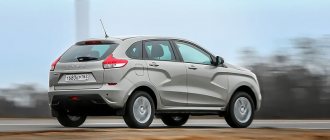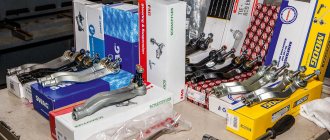In the fall, AVTOVAZ presented the updated Lada Vesta. Now this family is equipped with a Renault-Nissan alliance engine (1.6 l, 113 hp) and a continuously variable automatic transmission JF015E (hereinafter referred to as “variator” or CVT). We managed to find out how the car turned out during the test drive.
About the engine
Renault-Nissan HR16DE (1.6 l, 113 hp) is already familiar to us as H4M, because previously installed on Lada XRAY.
The main distinguishing features of this motor
:
- aluminum cylinder block;
- timing chain drive (no need to replace);
- automatic variable valve timing system, which improves filling of the engine cylinders in all operating modes;
- lack of hydraulic compensators (you will have to adjust the valves every 80 thousand km)
Specifications
:
- Maximum torque - 152Nm/4000rpm
- Maximum speed - 170 km/h
- Acceleration to 100 km/h - 12.2 seconds
- Fuel consumption in the combined cycle - 7.4 l/100km
The HR16DE/H4M engine is also installed on foreign cars: Nissan Note, Nissan Tiida, Nissan Qashqai, Nissan Sentra, Nissan Juke, etc. It has proven itself well among the owners of these cars and is an average engine.
Read more about this motor here.
AVTOVAZ's transition to the Renault-Nissan platform will also affect the Lada Vesta!
Based on sales results for the period from January to September of this year, Lada Vesta has finally overtaken Kia Rio in the ranking of the best-selling passenger cars on the Russian market. This Lada, let us remind you, was designed on its own platform, which AVTOVAZ began to develop even before the alliance with Renault-Nissan, so Vesta can with a clear conscience be called a domestic car. Meanwhile, further new Lada products will be based on the new Renault-Nissan-Mitsubishi platform – the so-called Global Access, which is a further evolution of the budget B0 “trolley” (it underlies the Lada Largus and Lada XRAY). Global Access, according to rumors, will be based on the new Lada 4×4, which will most likely return the historical name Niva, and the new Lada Granta. The same platform underlies the recently introduced Renault Arkana crossover for the Russian market.
What about Vesta? It turns out that she will also be affected by the transition to the new platform! This was announced in Togliatti at the 11th International Exhibition and Forum “Auto Industry. Automotive components”, Vice President for Purchasing of AVTOVAZ PJSC Venkatran Mamillapalle, his words are quoted by Autostat:
“Those models that are currently in production will change significantly by 2021. With the introduction of a new industrial platform, Lada Vesta will change, and the entire modern model range will change.”
However, it is unlikely that Vesta will change the platform - this would be too costly, especially now when the model’s release is in full swing. However, Vesta will most likely significantly change the range of components that AVTOVAZ purchases centrally through the structure of AVTOVAZ Renault Nissan Purchasing Organization LLC (ARNPO), created at the end of 2014.
In accordance with the requirements of the Federal Law on the development of localization and the Alliance’s own standards, the degree of localization should exceed 50% by 2021, and therefore the procurement department is searching for Russian suppliers who will be able to ship large quantities of components required by the quality standards of the Alliance to AVTOVAZ conveyors. We are talking, according to Mamillapalle, primarily about wheel drives, camshafts, turbochargers, connecting rods, oil pumps, brake boosters, brake discs, springs, generators, multimedia systems and roof rails. It is clear that all this is needed primarily to master the production of the Global Access platform, and Vesta, as they say, simply fell into disarray, and for now one can only guess how exactly it will change - the main thing is that it does not get worse.
It is curious that large foreign manufacturers of automotive components, for example the Bosch company, assemble their products in Russia entirely from imported components (even simple clamps are imported from abroad!), since they cannot obtain the required quality of raw materials, workpieces and parts from Russian subsuppliers. At the same time, a significant part of the production is exported, so no compromises regarding standards are possible.
The Renault-Nissan-Mitsubishi alliance also wants to supply components assembled in Russia abroad, and therefore the quality problem is no less acute for it. In fact, Mamillapalle and ARNPO need to perform a real miracle to achieve their 2021 goals. We, with bated breath, will watch what impact these “tectonic shifts” will have on the Lada Vesta.
About the variator
According to this site, the upgraded JF015E variator replaced the JF011E. The constructive idea is fundamentally different from its predecessor. The JF015E also has a torque converter that softens the load on the shafts, a planetary gear for reverse, but the main feature is two forward stages and three clutch packages: Direct No. 1 (Low), - No. 2 (High) and Reverse. This design made it possible to reduce the cone, increasing the gear ratio to a record 1:7.3 using two forward gears. Thus, this Jatco transmission can be called a two-speed CVT.
How Vesta drives with a CVT
During the test drive of the Lada Vesta with a CVT, the following features
:
- There is a creeping mode (in “D” mode, the car itself begins to move smoothly when the brake pedal is released).
- During acceleration, there is an imitation of gear shifting (during normal driving, shifting occurs at 3500 - 4000 rpm, at full throttle - after 5000 rpm).
- There is no monotonous howl of the engine during acceleration, which many owners of cars with a CVT do not like.
- “Shifting gears” occurs without the slightest jerk.
- In manual shift mode "M" there are 6 virtual gears.
- In manual mode, the virtual gear is automatically reset to 1st when stopped.
- In manual mode, the virtual gear will automatically shift at 5500 rpm (500-800 rpm higher than in "D" mode).
- Acceleration of the Lada Vesta SW Cross to 100 km/h with one passenger and a full trunk takes 16 seconds, without a passenger - 13.4 seconds (according to the passport 12.2 seconds).
- Acceleration of the Lada Vesta Cross sedan to 100 km/h was 12.7 seconds in one direction, 13.7 in the opposite direction (11.3 seconds according to the passport).
- Fuel consumption during fairly active mountain tests did not exceed 10.3 l/100km.
- The CVT settings keep the engine speed low, which allows the engine to be quieter than other transmissions (at 120 km/h your tachometer will read 2000 rpm).
- With a sharp start, a slight delay is felt before the start of movement.
- The engine braking capabilities of the car are very limited; there is no noticeable deceleration.
- Due to the appearance of new universal joints of the same length, now during acceleration, especially on poor surfaces, the steering wheel no longer breaks out of your hands, and there is more stability during emergency braking.
- Off the asphalt, the car feels very insecure (the car has difficulty crawling even on a grassy slope with a soft top layer, not to mention driving on a liquefied primer or slippery gravel).
- It is better to overcome steep climbs by walking. If you stop on such a hill, the variator sometimes rebels - when starting from a standstill, it releases the clutch and refuses to go further.
- The overtaking margin at speeds above 120 km/h is not enough, especially on mountain roads. On the plains the situation is better, but not globally. Even in manual mode it feels like you're driving in ECO mode.
In general, everything is simple, clear and practical. For the city, Vesta with a CVT is enough, but outside the asphalt the car feels very insecure. Have you ever driven a Lada Vesta with a CVT? What feedback and impressions can you leave?
Some features were taken from test drive data from wheels.ru and artemspec.
Motor 21129
It was with this version of the gasoline engine that AvtoVAZ presented the first Vesta six years ago. Here are some of its characteristics:
- fuel - gasoline;
- volume – 1.6 liters;
- power – 106 forces;
- torque – 148 Nm.
Today, such a motor is paired only with a manual transmission with five forward gears. But the robot boxes were left only for the Grant model. Many compare the 21129 motor with the 21127 motor, which is equipped with some Grants, some even come to the conclusion that this is the same engine, but despite the fact that they have a lot in common, 21129 has a number of modifications that cannot be ignored:
- modernized lubrication system;
- the oil sump received a larger volume and an aluminum design (in 127 there is a steel one);
- another option for the oil intake;
- For installation on vehicles on the B0 platform (Largus, XRAY and Vesta), the support fastening system has been redesigned.
To accelerate Vesta to hundreds, the engine will need a little more than 11 seconds. The maximum speed it will show is 182 kilometers per hour. And, if you believe the passport data, the fuel consumption of Vesta in this modification will be approximately:
- 9.3 liters in the city;
- 5.5 liters on the highway;
- about 6.9 liters with the combined version.
This engine is very popular not only in Russia, but also in the CIS countries. The whole point is in its comparative primitiveness; the engine, by modern standards, is technically very simple. Which makes its maintenance a simple and cheap process.
At the same time, it is very difficult to call it unreliable. Provided proper and timely maintenance, it will not cause any serious problems to the user, of course, if you use the car adequately and adhere to the basic recommendations of the manufacturer.
This engine is the best solution for a simple Vesta in a sedan. Its power is quite enough for the average user, and reliability and maintainability fully compensate for what the 1.8 liter engine can offer, and allow us to talk about a longer resource.
Prices
The version with a CVT will be 50 thousand more expensive than the version with a VAZ-21179 engine and manual transmission. With the launch of the CVT version, all trim levels have been updated:
- The most affordable version is the 1.6 sedan (113 hp), AT Jatco, Classic + Start Plus - 736,900 rubles.
- The maximum cost for Lada Vesta SW Cross 1.6 (113 hp), AT Jatco, Luxe + Prestige is 982,900 rubles.











